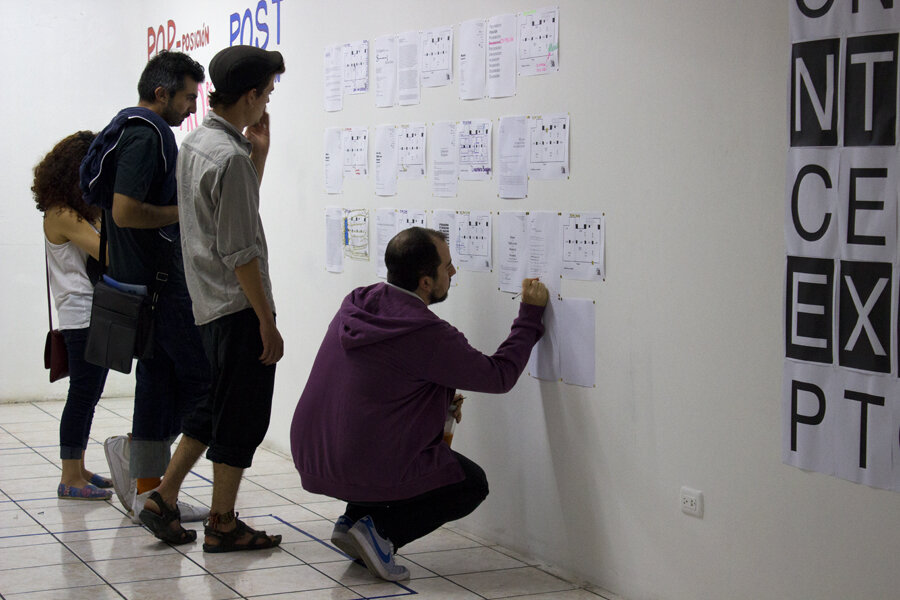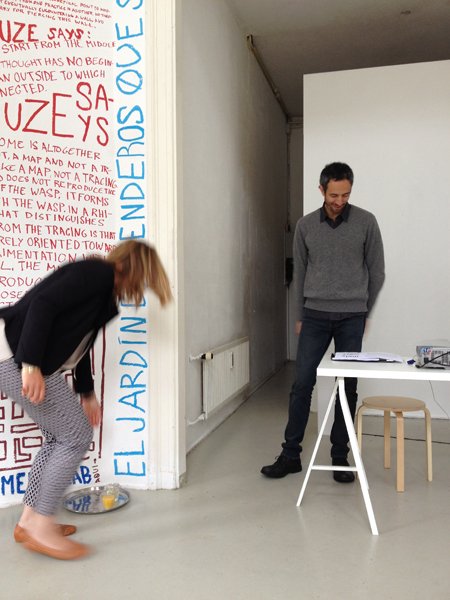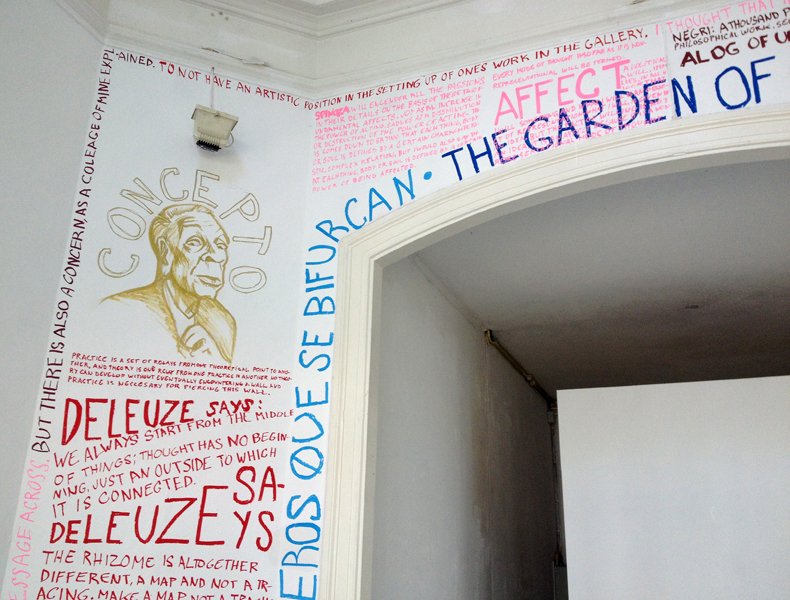Automatismos, Universidad Rafael Landívar
2016, A site-specific installation for the art gallery at Universidad Rafael Landivar in Guatemala, Three walls and two windows outline the space. In one wall there is a geometric composition formed by a set of self-written essays on the topic of “psychic automatism”, the text can be read onsite or they can also be dowloaded via a QR code located on the wall. On the other wall there are 21 envelopes mounted to the wall, each envelop contains a different instruction typed on the paper, for the audience to perform either there or away from the gallery. The other wall has a diagrammatic poster that proposes the combination of art+idea+process as value concepts for knowledge enquire. Finally, next to it there is a large text printed on vinyl letter types which alludes to the concepts of automatism and chance as proves for knowledge production.
In the case of this exhibition, the use of psychic automatism is proposed, not only as an exercise but as a revealing-liberating agent, as a trigger and as a possible way of unexpectedly entering the threshold of imaginations.
What we know about the thing is what we name; that is our limit, the indicative we assign to them. Now, what could be intriguing is everything we don't know about the thing, all that which has not yet been interpreted, manifested; that which remains hidden in the unconscious. How then do we look at what is not seen, or how to create text-images that we do not know?
The Surrealists proposed a series of simple mechanisms to access the unconscious of the thing. We refer to ‘psychic automatism’. Such a proposal conceives the automatism as an activity and as a metaphorizing vehicle that is capable of transporting things of the unconscious into the space of the conscious, converting the unknown into image, language, representation.
Propuestas Improbables, Sótano 1
2015, “…Within his own process, he realized that the best proposal he could give us was improvisation. It had never happened to us during the two years the gallery has been open, that someone would propose a Non-proposal.”
Gabriel Rodríguez*
In 2014 curators Gabriel Rodriguez and Diego Sagastume invited me to produce work for their legendary space S1, situated in the heart of Guatemala's downtown historical district. This relatively distinctive and informal venue located in the basement of a bar is actively hosting exhibitions from the local contemporary art scene.
On our first meeting the curators propose to lend me the space for one month to show some work. In response to their offer and after a few meetings, I propose that I will use the gallery as a studio for the duration of one month to do research, sketch possibilities, create interactive pieces for the audience and produce interventions on the walls of the gallery as means to detonate conversations. Finally, when I would have reached the time limit, we were to produce a public opening event to celebrate the closing of the event.
Although it lasted a month, it only lasted one day. During the month I produced a variety of pieces, we documented the processes and conducted philosophical, artistic and banal conversations systematically to activate artistic enquiry, also during this process visitors were allowed to join conversations and enquire on the working processes. The last day before taking the exhibition down legendary Guatemalan curator Rosina Cazali organised a guided visit and a conversation joined by fellow artists.
The work earned its name "Propuestas Improbables" towards the conclusion of the project, it was called like this because every week I came with one or two, or a few proposals to execute without knowing if they will be executed or not in the limit of the time frame. Uncertainty and play were essential components on this process, but not everything was left to chance because coincidentally I was deeply involved with a theoretical reflection on "Deleuze & Guattari's Rhizome Theory", which became not only a transversal axis, but also a matter of concern throughout the project.
Concepts at play, or playing with concepts became the bonding agent which kept all efforts into coherence; something that I came to call at the time: "Conceptual Ludicism or Ludic Conceptualism". Gabriel quotes in his article the following: “During the setting-up, he created several terms which, in my opinion, are one of his best contributions. The one I like the best is Conceptual Ludicism. He coined it as he was thinking about the Borgian Labyrinth drawn on the floor of the gallery.”
*Notes taken from the Nómada Magazine article: "Renato Osoy, La teoría y la práctica son lo mismo ¿o no?" (in Spanish only).
**A detailed list of the "Propuestas Improbables" project can be requested by email.
"Variations.Uniformity" at Bradwolff Projects
2014, “Deleuze & Borges Labyrinthic Encounter”, Part of the group exhibition "Variations.Uniformity" at Bradwolff Projects Amsterdam. The exhibition's point of departure is a shared interest in artistic research as a method of working. The notion itself – artistic research – is, just like the colour red, a collective term for a large amount of variations. To make these two words resonate with polymorphism and differences in nature. But like a uniform definition of red is claimed by specific cultures, artistic research does not seem to be associated with academic tools; it is for this group of artists.
The portal-mural piece evolves around the recurring notion in my work, that concepts can vary their meanings, depending on their context. The same is true for forms and colours and in mixture, these changes in meaning form a personal playground, using typography and the assets of the location as expressive tools.
Gilles Deleuze's notion of Rhizome, intertwines unexpectedly in a labyrinthic encounter with Jorges Luis Borges tale “El Jardín de los Senderos que se Bifurcan”, translated as “The Garden of Forking Paths”. The meditation on the nature of reality, space and time as fictional realms with infinite possibilities, and the consideration that perhaps every space-time node could work as the center of a system of branching or forking paths, as an ever-recurring moment of departure and encounter.
*The installation included a mural made with acrylic paint, a participative performative lecture with photocopies, sound and projections.
Relevant videos:
*https://vimeo.com/130811391 The video was made as a response to curator Alexandra Landre, on the question of an extended email, on how the installation was going to look as a finished piece. I replied to her questions with a question of process.



























